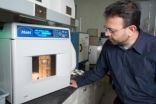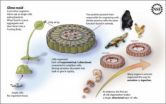(Press-News.org) A faster, better and cheaper desalination process enhanced by carbon nanotubes has been developed by NJIT Professor Somenath Mitra. The process creates a unique new architecture for the membrane distillation process by immobilizing carbon nanotubes in the membrane pores. Conventional approaches to desalination are thermal distillation and reverse osmosis.
"Unfortunately the current membrane distillation method is too expensive for use in countries and municipalities that need potable water," said Mitra. "Generally only industry, where waste heat is freely available, uses this process. However, we're hoping our new work will have far-reaching consequences bringing good, clean water to the people who need it."
The process is outlined in "Water Desalination Using Carbon Nanotube Enhanced Membrane Distillation," by Mitra and his research team in the current issue of the American Chemistry Society's Applied Materials & Interfaces. Doctoral students Ken Gethard and Ornthida Sae-Khow worked on the project. Mitra is chairman of the department of chemistry and environmental science.
Membrane distillation is a water purification process in which heated salt water passes through a tube-like membrane, called a hollow fiber. "Think of your intestines," said Mitra. "It's designed in such a way that nutrition passes through but not the waste." Using a similar structure, membrane distillation allows only water vapor to pass through the walls of the hollow tube, but not the liquid. When the system works, potable water emerges from the net flux of water vapor which moves from the warm to the cool side. At the same time, saline or salt water passes as body waste would through the fiber.
Membrane distillation offers several advantages. It's a clean, non-toxic technology and can be carried out at 60-90�C. This temperature is significantly lower than conventional distillation which uses higher temperatures. Reverse osmosis uses relatively high pressure.
Nevertheless, membrane distillation is not trouble free. It is costly and getting the membrane to work properly and efficiently can be difficult. "The biggest challenge," said Mitra, "is finding appropriate membranes that encourage high water vapor flux but prevent salt from passing through."
Mitra's new method creates a better membrane by immobilizing carbon nanotubes in the pores. The novel architecture not only increases vapor permeation but also prevents liquid water from clogging the membrane pores. Test outcomes show dramatic increases in both reductions in salt and water production. "That's a remarkable accomplishment and one we are proud to publish," said Mitra.
Another advantage is that the new process can facilitate membrane distillation at a relatively lower temperature, higher flow rate and higher salt concentration. Compared to a plain membrane, this new distillation process demonstrates the same level of salt reduction at a 20�C lower temperature, and at a flow rate six times greater.
"Together these benefits lead to a greener process which could make membrane distillation economically competitive with existing desalination technologies and we hope could provide potable water where it is most needed," said Mitra.
INFORMATION:
NJIT, New Jersey's science and technology university, enrolls more than 8,900 students pursuing bachelor's, master's and doctoral degrees in 121 programs. The university consists of six colleges: Newark College of Engineering, College of Architecture and Design, College of Science and Liberal Arts, School of Management, College of Computing Sciences and Albert Dorman Honors College. U.S. News & World Report's 2010 Annual Guide to America's Best Colleges ranked NJIT in the top tier of national research universities. NJIT is internationally recognized for being at the edge in knowledge in architecture, applied mathematics, wireless communications and networking, solar physics, advanced engineered particulate materials, nanotechnology, neural engineering and e-learning. Many courses and certificate programs, as well as graduate degrees, are available online through the Office of Continuing Professional Education.
NJIT prof offers new desalination process using carbon nanotubes
2011-03-15
ELSE PRESS RELEASES FROM THIS DATE:
Guided care reduces the use of health services by chronically ill older adults
2011-03-15
A new report shows that older people who receive Guided Care, a new form of primary care, use fewer expensive health services compared to older people who receive regular primary care. Research published in the March 2011 edition of Archives of Internal Medicine found that after 20 months of a randomized controlled trial, Guided Care patients experienced, on average, 30 percent fewer home health care episodes, 21 percent fewer hospital readmissions, 16 percent fewer skilled nursing facility days, and 8 percent fewer skilled nursing facility admissions. Only the reduction ...
Antioxidants in pregnancy prevent obesity in animal offspring
2011-03-15
New biological research may be relevant to the effects of a mother's high-fat diet during pregnancy on the development of obesity in her children.
An animal study at The Children's Hospital of Philadelphia suggests that a high-fat, high-carbohydrate diet causes oxidative stress -- an excess of deleterious free radicals -- during pregnancy, predisposing the offspring to obesity and diabetes. Feeding rats antioxidants before and during pregnancy completely prevented obesity and glucose intolerance in their offspring.
If the results in animals prove to be similar ...
Surgical technique helps adult male survivors of childhood cancer regain fertility
2011-03-15
A new study has shown that a surgical technique called microdissection testicular sperm extraction (TESE) can effectively locate and extract viable sperm in more than one-third of adult male childhood cancer survivors who were previously considered sterile due to prior chemotherapy treatment. As a result, many of the men were subsequently able to father children with the help of in vitro fertilization. The findings offer a new option for many cancer survivors who want to have children but were thought infertile because of earlier cancer treatment.
"It was previously ...
Tumor metastasis with a twist
2011-03-15
In the early stages of human embryogenesis, a transcription factor called Twist1 plays a key regulatory role in how the embryo assumes form and function. Much later in life, however, researchers at the University of California, San Diego School of Medicine, say Twist1 can re-emerge, taking a darker and more deadly turn.
In a paper published in the March 15, 2011 issue of Cancer Cell, UCSD scientists led by Jing Yang, PhD, assistant professor of pharmacology and pediatrics, identify a unique function of Twist1 in later life: it promotes the formation of invadopodia in ...
Painkiller prescribing varies dramatically among family physicians: study
2011-03-15
TORONTO, Ont., March 14, 2011 -- Some physicians are prescribing opioids such as OxyContin 55 times as often as others, according to a new study led by St. Michael's Hospital and the Institute for Clinical Evaluative Sciences (ICES). The study found most opioid-related deaths occur among patients treated by physicians who frequently prescribe opioids, suggesting doctors who prescribe a lot of opioids may not be doing so safely.
"We found that the 20 per cent of family doctors who are frequent prescribers wrote 55 times as many prescriptions as the 20 per cent of family ...
Study shows why people read magazines featuring envy-inspiring models
2011-03-15
COLUMBUS, Ohio – New research reveals why people read fitness and fashion magazines featuring photos of impossibly thin or muscular models -- models whose appearance highlight the readers' own flaws.
Many previous studies have found that people who are unhappy with their physical appearance feel even more dissatisfied when they are shown photos of models who have "ideal" bodies.
"So you have to wonder: why do we still buy those magazines and watch those television programs when they should just make us more dissatisfied?" said Silvia Knobloch-Westerwick, associate professor ...
Toxoplasmosis: The strain explains severity of infection
2011-03-15
Providing clues into why the severity of a common parasitic infection can vary greatly from person to person, a new Johns Hopkins study shows that each one of three strains of the cat-borne parasite Toxoplasma gondii sets off a unique reaction in the nerve cells it invades.
Past research suggests that the parasite, estimated to infect 25 percent of people worldwide, can trigger or exacerbate psychotic symptoms and schizophrenia in genetically predisposed people.
The findings of the new study, published in the March issue of the journal Infection and Immunity, help explain ...
New research focuses on prion diseases
2011-03-15
New research by Chongsuk Ryou, researcher at the UK Sanders-Brown Center on Aging and professor of microbiology, immunology and molecular genetics in the UK College of Medicine, may shed light on possible treatments for prion diseases.
Prion diseases, which include Creutzfeldt-Jakob disease in humans and bovine spongiform encephalopathy ("mad cow" disease) in cattle, are caused by prions — unconventional pathogens composed of infectious protein particles and resistant to conventional sterilization procedures. Presently there is no known agent or procedure that can halt ...
Teens and young adults with cancer face unique challenges and require targeted care
2011-03-15
New Rochelle, NY, March 14, 2011–Adolescents and young adults are neither children nor adults and those affected by cancer require targeted care that crosses the boundaries between pediatric and adult oncology, according to several pioneers in this still-developing field of adolescent and young adult oncology. An illuminating roundtable discussion by these experts will be published in the premier issue of Journal of Adolescent and Young Adult Oncology, a multidisciplinary peer-reviewed publication of Mary Ann Liebert, Inc. (www.liebertpub.com). The Roundtable has been published ...
How the slime mold gets organized
2011-03-15
The so-called cellular slime mold, a unicellular organism that may transition into a multicellular organism under stress, has just been found to have a tissue structure that was previously thought to exist only in more sophisticated animals. What's more, two proteins that are needed by the slime mold to form this structure are similar to those that perform the same function in more sophistical animals.
Shortly after an animal embryo forms, it develops a single layer of cells that, shaped like a hollow ball, is empty at its center. Acting as a kind of "man behind the curtain" ...


